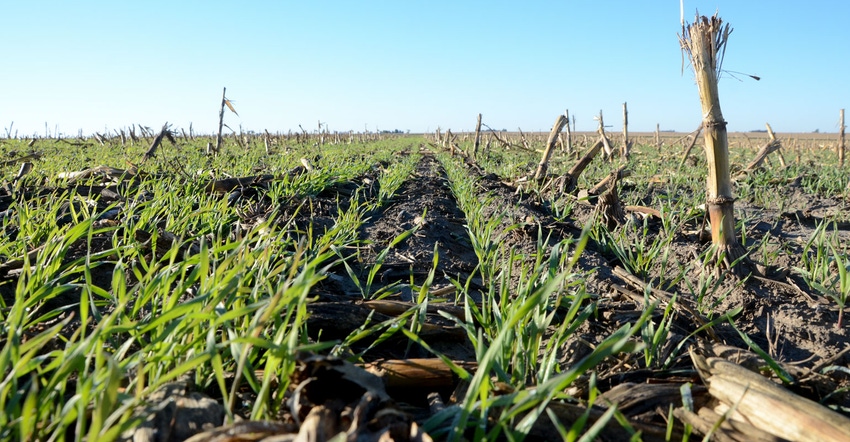September 16, 2021

Carbon sequestration programs that pay farmers may appear to be popping up like mushrooms on a hot spring day — and you may find more options moving into the 2022 crop year. As one example, Corteva is expanding its pilot program to cover more crops and more states.
“We’re expanding the program,” says Casey Onstot, U.S. commercial leader, digital, at Corteva. “And we’re partnering with Carbon by Indigo in this program.”
Here are a few changes offered in the expanded program:
Incentive to start. Farmers will receive 75% of the credit value, so as future prices rise, they capture the majority of the upside.
Higher prices. Farmers that generate the highest-quality credits built on Indigo’s program can maximize the value. Based on market projections, farmers could earn as much as $30 or more per credit, with the added security of a guaranteed minimum payment of $15 per credit.
More states. The program is now available in 11 states, including Illinois, Indiana, Iowa, Kansas, Minnesota, Missouri, Nebraska, North Dakota, South Dakota, Ohio and Wisconsin.
Expanded crops and practices. In addition to cover crops or tillage changes, increased nitrogen use efficiency is an eligible practice change. The initiative now supports 17 of the most common crop types across the U.S. (but is limited to that current geography for 2022).
Past practices. Farmers will get paid on eligible practice changes from the past that were started after 2020’s harvest.
In addition to these changes, Onstot adds that unlike other programs, this one has some flexibility for farmers. “This is a five-year agreement, but we allow the farmer to opt out in any of those five years,” he says. “We want to earn the growers’ business and make sure it’s right for their farm.”
He acknowledges that this opt-out provision does provide some risk for Corteva as part of the program, given that “permanence” is an important component for any carbon sequestration program. If farmers opt out, that can hurt the long-term health. Corteva is taking the risk and managing that issue for permanence.
A new partner
In the pilot program, Corteva had teamed with the Ecosystems Services Marketing Consortium, and farmers who entered into that agreement will still get support.
The 2022 program is with Indigo, which has its own methods for verifying on-farm practices to be sure they’re having the desired effect. “Where Indigo has really helped us is what practices generate how many tons of carbon,” Onstot says.
He adds that Indigo has partnerships in industry to sell the carbon credits and the offsets, too. “That’s allowed us to extract more value for the customer and give more of that value back,” he says.
The Granular Ag tools offered through Corteva allows farmers to help capture the information needed to get those payments. “We have a team of experts to work with those farmers to help them choose the right agronomic practices to make sure it fits their farm and, ultimately, earn the carbon credit payment,” he adds.
Insight from Indigo
Kari Hernandez, head of carbon opportunities at Indigo, was positive about the new agreement. “This partnership lets us do what we’re good at and work with someone else, and let them do what they’re really good at,” she notes.
She says the Task Force on Scaling Voluntary Carbon Markets estimates 2 billion carbon credits in demand for the next decade. “There are very high-quality standards for that 2 billion demand we’ll be looking for,” she notes.
Indigo needs to know what it buys is quality, and as Hernandez says, “It’s never been done in ag before.”
To build this, Indigo is working with the Climate Action Reserve in the United States — a carbon registry that has a set of guidelines. These are:
Realness. If you generate a carbon credit, you can’t overestimate it.
Additionality. This means a grower doing something differently. The buyer sees it as a catalyst for change.
Permanence. It’s important that buyers know they’re looking at the reduction of 1 ton of carbon forever. In agriculture, that is difficult due to management changes, and it’s important to have a way to manage for that.
Leakage. This is a concept more farmers may hear about. “If you reduce your carbon emissions in one place — let’s say one farm and you lost a bunch of yield — you would have to go generate that same yield likely at a higher emissions rate,” Hernandez says.
She notes that the practices have to be initiated in a way that won’t impact yield, which can lead to leakage.
Indigo is taking on the role of measurement and verification in the program. This involves looking at models of practices, and then performing soil tests to verify that the practices are doing the job.
Corteva has a message for farmers looking at carbon programs: Don’t wait.
“I hear farmers say they’ll wait to see where this goes,” Onstot says. “That’s not the right approach — better to get in a program now, early, to be part of this.”
Given the large amount of carbon credits to generate, the opportunity is there for these payments to continue rising into the future, but the farmer that waits will miss that opportunity since the process to get into the program takes time. Learn more about the new program at granular.ag/carbon.
About the Author(s)
You May Also Like






